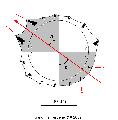Descripteur : Axis of orientation of the synlophe
In the transverse section, the apex of the ridges maybe directed perpendicular to, or oblique to, the body surface. In the latter case, an axis of orientation generally exists which separates ridges pointing in opposing directions. This axis passes between ventral right and dorsal left quadrant. During the course of evolution starting from a single oblique axis (plesiomorphic state), anindependent rotation of this axis on the right and left sides may bring about a double-axis state with a different inclination on both sides (derivated state). When the rotation reaches 90° for bath sides, the axis becomes simple once again and is superimposed to the frontal axis (most derivated state)
(See images)
In Heligmonellinae, the ridges are oblique compared to the wall of the body (leaning towards the right-handside or the left compared to surface).
One thus defines an axis of orientation, which separates the ridges pointing in opposite directions.
This axis passes by the ventral quarter right and the left dorsal quarter of the synlophe. One can then distinguish two cases:
- only one axis is observed: it is named "general axis”;
- or 2 different axes are observed in the ventral quarter right and the left dorsal quarter. They are then named“right axis”(in the ventral quarter right) and“left axis”(in the left dorsal quarter).
we measures the angle which these axes by report to the sagittal axis (dorso-ventral).
On average, in Heligmonellinae, these angles are included between 45 and 55°.
Hiérarchie
Axis of orientation of the synlophe | |_ Only a general axis {2 axes} | |_ Right axis {1 axis} | |_ Left axis {1 axis}


